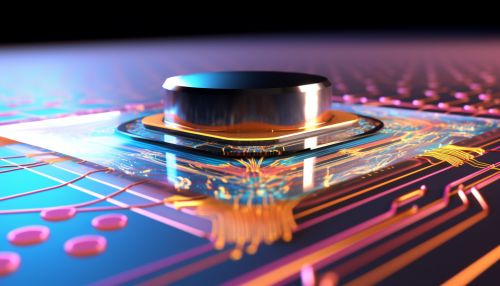Semiconductor laser
Introduction
A semiconductor laser, also known as a laser diode, is a device that emits light through the process of stimulated emission. The light that is emitted is usually in the form of a narrow beam, which can be manipulated and controlled for various applications. Semiconductor lasers are widely used in numerous fields, including telecommunications, medicine, and consumer electronics.
Principle of Operation
A semiconductor laser operates based on the principle of stimulated emission, a process that was first proposed by Albert Einstein in 1917. When an electron in a higher energy state encounters a photon of light with energy equal to the energy difference between its current energy state and a lower energy state, it can be stimulated to drop to the lower energy state, emitting a second photon of light in the process. This second photon has the same phase, frequency, polarization, and direction of travel as the original photon, leading to the amplification of the light beam.
Structure
The structure of a semiconductor laser is composed of several layers of semiconductor materials. These layers form a p-n junction, which is a boundary between two types of semiconductor material: p-type, which has a surplus of holes (absence of electrons), and n-type, which has a surplus of electrons. The p-n junction is where the process of stimulated emission occurs, leading to the generation of laser light.


Types of Semiconductor Lasers
There are several types of semiconductor lasers, each with its own unique properties and applications.
Edge Emitting Lasers
Edge emitting lasers are the most common type of semiconductor laser. They emit light from the edge of the semiconductor material, which is why they are named as such. Edge emitting lasers are used in a wide range of applications, including fiber optic communications and laser printers.
Vertical Cavity Surface Emitting Lasers
Vertical Cavity Surface Emitting Lasers (VCSELs) are a type of semiconductor laser that emit light from the surface of the semiconductor material, rather than the edge. VCSELs are used in applications such as data communications and sensing.
Quantum Cascade Lasers
Quantum Cascade Lasers (QCLs) are a type of semiconductor laser that operate in the mid-infrared to terahertz range. QCLs are used in applications such as spectroscopy and chemical sensing.
Applications
Semiconductor lasers have a wide range of applications, thanks to their small size, high efficiency, and the ability to directly convert electrical energy into light.
Telecommunications
In the field of telecommunications, semiconductor lasers are used in fiber optic communication systems. The laser light is used to carry information over long distances through optical fibers.
Medicine
In medicine, semiconductor lasers are used in various procedures, including laser eye surgery and photodynamic therapy for cancer treatment.
Consumer Electronics
In consumer electronics, semiconductor lasers are used in devices such as DVD and Blu-ray players, where they are used to read the information stored on the discs.
